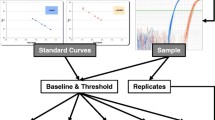Abstract
Randomised experimental designs are considered statistically advantageous for many scientific applications, as they reduce the effect of problematic parameters such as sample position. The effect of randomisation was assessed using real-time PCR experiments for the determination of genetically modified material. Replicate microtitre plates using a randomised design were compared with replicate microtitre plates that contained the same samples allocated in a systematic fashion to experimental position within the plate. Results indicated that randomisation would help reduce between-plate variability and would give advantages in intra-laboratory studies. However, these benefits may be less effective for inter-laboratory studies as the between-laboratory variability often far exceeds the between-plate variability.



Similar content being viewed by others
Notes
Additional strategies, such as blocking or latin square designs, can provide greater benefits for comparisons within an experiment than randomisation alone if nuisance effects are likely to apply to identifiable groups of observations (the presence of consistent row effects in 96-well plates would be a good example). This is, however, beyond the scope of the present paper.
References
Manly B (1997) Randomization, bootstrap and Monte Carlo methods in biology (2nd edn). Texts in statistical science. Chapman & Hall, London, UK. ISBN-10 0412721309
Anderson V, McLean R (1974) Design of experiments: a realistic approach. Marcel Dekker, New York
Greenberg B (1951) Why randomize? Biometrics 7:309–322
El-Kassaby Y, Reid D (2007) Is randomization necessary in seed orchards? 29th SFTIC, Event Galveston, TX–2007
Thornett M (2008) The role of randomization in model-based inference. Aust N Z J Stat 24(2):137–145
Harville D (1975) Experimental randomisation: who needs it? Am Stat 29:27–31
The fitness for purpose of analytical methods—A laboratory guide to method validation and related topics—Eurachem guide (1998) ISBN: 0-948926-12-0 http://www.eurachem.org/guides/valid.pdf
Thompson M, Fearn T (1996) What exactly is fitness for purpose in analytical measurement? Analyst 121(3):275–278. doi:10.1039/AN9962100275
Burns M, Valdivia H (2008) Modelling the limit of detection in real-time quantitative PCR. Eur Food Res Technol 226(6):1513–1524. doi:10.1007/s00217-007-0683-z
Arumuganathan K, Earle E (1991) Nuclear DNA content of some important plant species. Plant Mol Biol Rep 9:211–215
Burns M, Corbisier P, Wiseman G, Valdivia H, McDonald P, Bowler P, Ohara K, Schimmel H, Charels D, Damant A, Harris N (2006) Comparison of plasmid and genomic DNA calibrants for the quantification of genetically modified ingredients. Eur Food Res Technol 224(2):249–258. doi:10.1007/s00217-006-0376-z
Pinheiro J, Bates D, DebRoy S, Sarkar D (2009) Linear and nonlinear mixed effects models. R package version 3.1-95
R Development Core Team (2008) R: a language and environment for statistical computing. R Foundation for Statistical Computing, Vienna, Austria. ISBN 3-900051-07-0, URL http://www.R-project.org
Burns M, Nixon G, Foy C, Harris N (2005) Standardisation of data from real-time quantitative PCR methods—evaluation of outliers and comparison of calibration curves. BMC Biotechnol 5:31. doi:10.1186/1472-6750-5-31
Trapman J, Burns M, Broll H, Macarthur R, Wood R, Zel J (2009) Guidance document on measurement uncertainty for GMO testing laboratories. RC Scientific and Technical Report ISBN 978-92-79-11228-7. http://irmm.jrc.ec.europa.eu/reference_materials_catalogue/user_support/Documents/eur22756en.pdf
European union reference laboratory for GMOs in Food and Feed (EURL-GMFF) validation reports http://gmo-crl.jrc.ec.europa.eu/statusofdoss.htm
Bellochi G, Acutis M, Paoletti C, Confalonieri R, Trevisiol P, Grazioli E, Delobel C, Savini C, Mazzara M, Van den Eede G (2008) Expanding horizons in the validation of GMO analytical methods: fuzzy-based expert systems. Food Anal Methods 1:126–135
Community Reference Laboratory for GM Food and Feed, Validation Report Maize MON 810: CRL assessment on the validation of an event specific method for the relative quantitation of maize line MON 810 DNA using real-time PCR as carried out by Federal Institute for Risk Assessment (BfR). http://gmo-crl.jrc.ec.europa.eu/summaries/Mon810_validation_report.pdf
Thompson M, Ellison S, Wood R (2002) Harmonized guidelines for single-laboratory validation of methods of analysis. Pure Appl Chem 74:835–855
Fearn T, Fisher S, Thompson M, Ellison S (2002) A decision theory approach to fitness for purpose in analytical measurement. Analyst 127:818. doi:10.1039/b111465d
Acknowledgments
The authors thank Hernan Valdivia (LGC) for his valuable contribution with respect to conducting the practical work associated with the experiments. The work described in this paper was funded in part by the UK National Measurement System. The authors gratefully acknowledge funding provided by the 6th EU Framework Programme for Research and Technological Development (FP6) project ‘GM and non-GM supply chains: their CO-Existence and TRAceability” (Contract number 007158).
Author information
Authors and Affiliations
Corresponding author
Rights and permissions
About this article
Cite this article
Burns, M., Ellison, S. The fitness for purpose of randomised experimental designs for analysis of genetically modified ingredients. Eur Food Res Technol 233, 71–78 (2011). https://doi.org/10.1007/s00217-011-1485-x
Received:
Revised:
Accepted:
Published:
Issue Date:
DOI: https://doi.org/10.1007/s00217-011-1485-x




